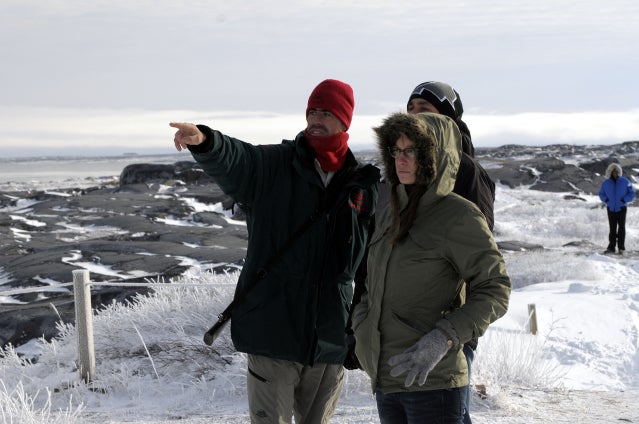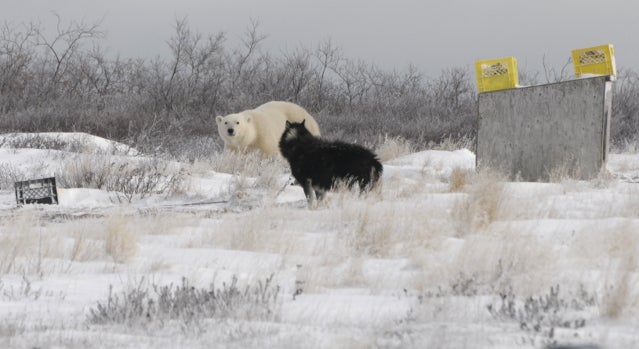
One of the ironies of Churchill is that its residents, who have so much to lose from climate change, often have to drive for their own safety. Signs emblazoned with the silhouette of a polar bear warn pedestrians not to walk in certain areas around town and on the banks of the Churchill River. People leave their cars, and sometimes their houses, unlocked, in case they or a passerby need to make a quick escape from a hungry animal.
Like Juneau, Alaska, there’s no way to get to Churchill by car—Highway 6 ends in Thompson, several hours south. Visitors either fly or take a two-day train ride from Winnipeg. Food comes in by rail or through the port, a concrete hulk on a nearby inlet that freezes solid in the winter.
Churchill itself is tiny, a cluster of modular buildings, peaked-roof rowhouses, and ranches with peeling paint, huddled together on the shore of Hudson Bay. It has three churches and a handful of bars. In the only supermarket, shelves of cereal share floor space with snowmobiles and racks of $700 Canada Goose down coats.
On our first morning in town, the Explore.org crew headed out to Cape Merry, a point of land extending out into the mouth of the Churchill River. Near the car, we met a chipper Parks Canada ranger named Dwayne, who told us that there was a polar bear on the other side. He led us past a cairn commemorating the Jens Munk expedition to the ruins of an old stone battery overlooking the water. Through my long lens I could just barely make out the creamy white shape pacing around the snow-covered rocks on the far shore.
Nearby, another ranger, Dave, stood watch with a pump-action shotgun slung across his back. Dave, a native of northeastern England, was in his first season working for Parks Canada. He’d never had to shoot a bear, he said; as far as he could remember, no Canadian park ranger had had to in about 30 years.

There are slightly over 900 polar bears in the Churchill area, and the people who live there have no illusions about how dangerous they can be. “I don’t think the bears are trying to kill me,” Neil Mumby, a buggy driver for tour operator Frontiers North Adventures, told me. “But they may want to play with me, which would kill me.” During the season, no one, including reasearchers, heads into the backcountry unarmed.
Driving up the coast, we passed a roadside kennel with several dozen Canadian Eskimo dogs. A group of them was barking and whining furiously, rattling their chains as they ran back and forth. It took us a moment to notice the polar bear raiding their food.

The bear was young, probably not fully grown yet, and likely starving after living off its fat for months. The dogs ran circles around it, staying just out of its reach, but the bear was having one of the easiest meals of its life, and wasn’t about to give it up. As a dog approached, it would crouch like a wrestler going into a stance and charge, then wheel around and chase off another that had approached it while its back was turned.
After about 10 minutes, the bear patrol turned up in two pickup trucks to chase the animal off. Two small groups of people got out; soon after, three sharp pops sounded as they fired into the air. We watched from a distance as the bear hightailed it up the shore and disappeared into the brush.
—Adam Roy
@adnroy
